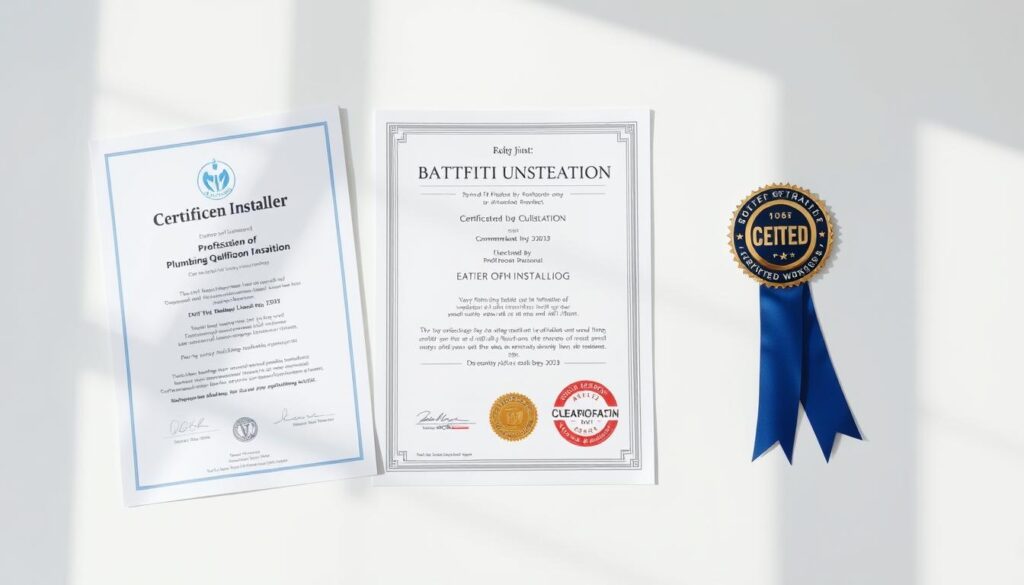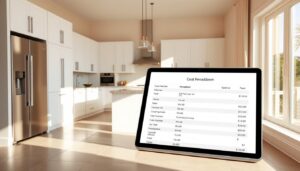Refreshing your bathroom can be an exciting yet daunting task, especially when budgeting for the project. In 2024, rising material prices and labour shortages have influenced the overall expenses, making careful planning essential.
The typical price for a complete update ranges between £4,000 and £12,000, depending on the room’s size and complexity. Hidden costs, such as plumbing adjustments or structural changes, can also affect the final bill.
Regional differences play a role too—London and the Southeast often see prices 15-25% higher than other areas. Key factors like materials, labour, and design choices will shape your total spend.
For a deeper dive into budgeting, explore our guide on average bathroom fitting costs.
Key Takeaways
- Prices vary based on size, materials, and labour.
- Unforeseen issues may increase the final expense.
- London and the Southeast tend to be pricier.
- Design complexity impacts the overall budget.
- Proper planning helps avoid unexpected costs.
Introduction to Bathroom Renovation Costs in the UK
Planning a bathroom makeover in 2024? Prices have shifted due to market changes. The average bathroom renovation now ranges from £4,000 to £6,000—up from £3,000–£5,000 pre-pandemic. Labour shortages and material delays have pushed costs higher, with some fittings taking three months to arrive.
Despite the rise, these upgrades offer solid value. A well-executed project can boost your property’s worth by 60–70%. Whether you hire professionals or DIY affects both risk and budget. Here’s a quick comparison:
| Approach | Average Cost | Time Required |
|---|---|---|
| Professional Installation | £150–£300 per m² | 2–4 weeks |
| DIY | £50–£150 per m² | 4+ weeks |
Timing matters too. Many contractors offer 10–15% discounts in winter. If you’re flexible, you could expect pay less without cutting corners.
For a clearer picture, measure your space and use the cost-per-square-metre rule. This helps avoid surprises later. Smaller bathrooms often cost less, but complex layouts or premium tiles add up fast.
Breakdown of Bathroom Renovation Costs
Understanding where your money goes during a bathroom upgrade helps avoid budget shocks. From tiles to tradespeople, each element impacts your total spend. Here’s a detailed look at the key expenses.
Material Costs: Tiles, Fixtures, and Fittings
Materials typically consume 40–50% of your budget. Ceramic tiles start at £15 per m², while natural stone can exceed £100 per m². Mixing premium and mid-range options balances cost and style.
Fixtures like taps and showers range from £50–£500, depending on finishes. Freestanding baths add a luxury touch but cost £800–£2,500. Always compare suppliers for bulk discounts.
Labour Costs: Installers and Tradespeople
Skilled labour ensures quality but comes at a price. Plumbers and tilers charge £150–£300 per day. Complex layouts or high-end materials may increase time—and costs.
| Service | Daily Rate | Project Duration |
|---|---|---|
| Tiling | £200–£250 | 3–7 days |
| Plumbing | £180–£300 | 2–5 days |
| Electrical Work | £150–£220 | 1–3 days |
Additional Expenses: Plumbing, Electrical, and Waste
Hidden fees often lurk behind walls. Moving soil pipes costs £800–£1,200, while local updates are cheaper. Underfloor heating adds £1,000–£1,800 but boosts comfort.
Skip hire for waste removal averages £250–£400. Don’t forget building regulation certificates (£150–£300) or post-installation cleaning (£200–£300).
Key Factors Affecting How Much a Bathroom Renovation Costs in the UK
From room dimensions to regional rates, numerous factors shape your project’s expense. Whether you’re modernising a compact ensuite or a spacious family washroom, understanding these variables helps avoid budget surprises.
Size and Layout of Your Washroom
Larger spaces need more materials. This escalates costs quickly. Compact layouts, however, save on tiles and fittings.
Odd-shaped rooms or awkward plumbing placements may require custom solutions. For example, relocating a toilet adds £800–£1,200 to labour fees.
Quality of Materials and Fixtures
Porcelain tiles cost £20–£60 per m², whereas vinyl offers savings at £10–£30 per m². High-end brass taps (£200+) outlast budget chrome alternatives.
Mixing materials balances aesthetics and affordability. Consider splurging on a statement basin but saving on cabinet handles.
Complexity of Design and Structural Changes
Knocking down walls or installing underfloor heating increases spend. Structural work alone can add £1,500–£3,000.
Minimalist designs with standard fittings keep costs predictable. Intricate mosaics or bespoke shelving demand extra time and skill.
Regional Variations in Pricing
London’s prices soar 25% above the national average. In contrast, Manchester offers more competitive tradespeople rates.
- Rural challenges: Remote areas like the Scottish Highlands face higher material transport fees.
- Urban demand: Brighton contractors charge 10–15% more than Leeds due to local demand.
Negotiate firmly in competitive markets. Many installers match quotes to secure work.
Average Costs by Bathroom Size
The size of your washroom plays a crucial role in determining renovation expenses. Smaller spaces often cost less but may require clever design to maximise functionality. Larger areas, meanwhile, demand more materials and labour, pushing budgets higher.
Small Bathroom or Ensuite Renovation
Compact layouts, typically under 5m², range from £2,500 to £5,000. Prioritise space-saving options like wall-hung basins or sliding showers. Premium finishes in small doses—such as mosaic borders—add flair without overspending.
Medium-Sized Bathroom Renovation
For rooms around 6–10m², expect to pay £5,000–£8,000. This allows for mid-range tiles and quality fixtures. Freestanding tubs or double vanities fit comfortably here, blending practicality with style.
Large or Luxury Bathroom Renovation
Spaces exceeding 10m² can cost £6,000–£12,000, with high-end projects reaching £18,500+. Luxury touches like steam showers (£2,500+) or heated towel racks elevate the experience. Natural stone surfaces and smart features (voice-controlled lighting, £300–£600) future-proof your investment.
“A Cotswolds client splurged on a £18,500 spa-style retreat—complete with a rainfall shower and bespoke oak cabinetry.”
- Accessibility upgrades: Walk-in baths (£1,200+) or grab rails (£80–£150) cater to long-term needs.
- Material choices: Porcelain replicas mimic marble at half the price (£40/m² vs. £100/m²).
- Hidden costs: Structural reinforcement for freestanding baths adds £500–£1,000.
Cost Comparison: New Bathroom Installation vs. Renovation
Deciding between a full replacement or a refresh? Each option has its merits, depending on your budget and goals. While a complete overhaul offers a blank canvas, refurbishing can save money while still delivering impressive results.
Pros and Cons of a Full Replacement
A brand-new installation gives you total creative freedom. You can redesign the layout, upgrade plumbing, and choose modern fixtures. However, this approach typically costs 40–50% more than refurbishing.
Consider these points:
- Higher initial spend: Expect £4,500+ for medium-sized spaces
- Longer timeline: 3–6 weeks versus 1–2 weeks for cosmetic updates
- Structural changes: Moving walls or pipes adds complexity
When Refurbishing Makes More Sense
If your current layout works well, a refresh could slash expenses by 30–40%. Clever updates like regrouting tiles or repainting cabinets create impact without the hassle of demolition.
Strategic mixing preserves character while modernising key elements:
- Keep a quality bathtub but replace dated taps
- Install new lighting around existing mirrors
- Use vinyl flooring over tired tiles for instant transformation
“Our £1,200 refresh—new fixtures, fresh grout, and a resurfaced bath—looked like we’d spent £4,000.”
For more detailed comparisons, explore our guide on bathroom transformation costs.
How to Budget for a Bathroom Renovation in 2024
Smart financial planning turns bathroom upgrades from stressful to satisfying. With 80% of projects uncovering hidden issues, a clear budget acts as your safety net. Start by evaluating priorities—whether it’s a sleek new shower or durable tiles—to allocate funds effectively.

Setting a Realistic Budget Range
Base your calculations on room size and material quality. For a medium-sized space, £5,000–£8,000 typically covers mid-range fittings and labour. Always:
- Request itemised quotes from three contractors
- Add 10–15% for regional price variations
- Factor in work timelines—delays increase temporary accommodation costs
Cost-Saving Tips Without Sacrificing Quality
Keep the layout unchanged to avoid plumbing adjustments (£800+). Opt for:
- Porcelain tiles mimicking marble (£40/m² vs. £100/m²)
- Refurbished fixtures instead of brand-new replacements
- Off-peak discounts by scheduling in winter
Why a Contingency Fund Is Essential
Four in five renovations reveal surprises like asbestos or faulty wiring. A example: one homeowner faced a £1,200 overage on a £10,000 project due to water damage. Protect yourself by:
- Reserving 15–20% of your total budget
- Reviewing insurance policies for renovation coverage
- Negotiating change orders upfront with contractors
“Our contingency fund saved us when we discovered rotten floorboards—without it, we’d have stalled halfway.”
Getting Quotes from Bathroom Installers
A quarter of renovation complaints stem from poorly vetted tradespeople. Gathering multiple quotes ensures you pay a fair price and avoid subpar work. Take time to scrutinise each detail—this upfront effort prevents headaches later.
How to Compare Quotes Effectively
Look beyond the bottom line. A detailed breakdown reveals where costs vary. For example, one installer might include waste removal, while another charges extra.
| Quote Component | What to Check |
|---|---|
| Labour Costs | Daily rates vs. fixed project fees |
| Materials | Brands and quality specified |
| Timeline | Start date and estimated completion |
Ask for itemised lists. Vague descriptions like “tiling services” hide potential extras. Reputable firms provide clear, line-by-line estimates.
Red Flags to Watch Out For
Pressure to sign quickly or demands for over 25% upfront often signal trouble. Verify certifications—Gas Safe registration for plumbers, for instance—before committing.
Contracts should outline change order policies. Surprise fees for minor adjustments suggest poor planning. One homeowner reported a £900 overage for moving a sink by 30cm.
“Our installer’s five-star reviews masked three unresolved complaints. Cross-checking multiple platforms saved us from a disaster.”
Finally, trust your instincts. If a quote seems too good to be true, it usually is. Balance cost with credibility for the best results.
Choosing the Right Bathroom Installer
Selecting a skilled professional for your project ensures quality results and peace of mind. The right installer transforms your vision into reality while avoiding costly mistakes.

Why Professional Installation Matters
Expert tradespeople bring precision and efficiency to your project. They handle complex tasks like waterproofing and pipework—areas where DIY often falls short.
Consider these advantages:
- Guaranteed workmanship: Registered professionals offer warranties on labour
- Compliance assurance: Properly installed electrics and plumbing meet building regulations
- Time savings: Experienced teams complete projects 30–50% faster than amateurs
“Our installer spotted potential damp issues we’d missed—saving us £2,000 in future repairs.”
How to Verify Credentials and Reviews
Always check qualifications before hiring. Essential certifications include:
- NVQ Level 2 in plumbing or tiling
- WaterSafe registration for water system work
- NICEIC approval for electrical installations
Review platforms like TrustATrader help identify reliable professionals. Look for:
- Detailed feedback across multiple projects
- Responses to negative reviews showing problem-solving
- Before-and-after portfolio images
| Trade Body | Coverage |
|---|---|
| Federation of Master Builders (FMB) | General construction standards |
| British Institute of Bathroom Installers (BIBA) | Specialist bathroom expertise |
Request references from recent clients. A trustworthy installer will gladly share contact details for verification.
Hidden Costs of Bathroom Renovations
Behind every stunning bathroom lies a list of often-overlooked expenses. While tiles and taps dominate initial quotes, unforeseen issues and future upkeep can strain budgets. Planning for these ensures your project stays on track.
Unexpected Structural or Plumbing Issues
One in three renovations uncovers problems like damp patches or outdated pipework. Rewiring corroded plumbing averages £800–£1,500, while repairing rotten floor joists adds £1,200–£2,000. Always inspect behind walls before finalising designs.
Pro tip: Contractors often include a 10% contingency for structural surprises. If they don’t, request a revised quote.
Long-Term Maintenance Expenses
A pristine bathroom requires regular care to stay functional. Annual upkeep typically ranges from £100–£200, but neglect can triple these costs. Key tasks include:
- Grout resealing: Every 2–3 years (£40–£80) prevents water damage
- Silicone replacement: Biennial updates (£30–£60) stop mould growth
- Ventilation servicing: Clean extractor fans annually (£50–£90)
| Task | Frequency | Estimated Cost |
|---|---|---|
| Tap washer replacement | As needed | £15–£40 per tap |
| Showerhead descaling | Twice yearly | £20–£50 |
| Energy efficiency upgrades | 5–10 years | £200–£500 |
“We skipped resealing for five years—our £80 oversight became a £1,200 wall rebuild.”
Factor these into your long-term plans. A well-maintained bathroom retains value and avoids emergency repairs.
Tips to Save Money on Your Bathroom Renovation
Smart spending strategies can transform your space without draining your wallet. By focusing on value-driven choices, you’ll achieve a stylish yet practical result.
Prioritising High-Impact, Low-Cost Upgrades
Small changes often deliver the most noticeable improvements. Peel-and-stick tiles offer an affordable alternative to natural stone, starting at just £10 per m². Limit tiling to wet areas like showers to cut material costs by 30–40%.
Consider these budget-friendly swaps:
- Refurbished fixtures: Ex-display items provide luxury looks for 50–60% less
- Vinyl flooring: Modern designs mimic wood or stone at £15–£25 per m²
- Upcycled furniture: Repainted cabinets save £200–£400 on storage
“We refreshed our entire suite with ex-showroom fittings—saving £1,200 without compromising quality.”
Where to Splurge and Where to Save
Allocate your budget wisely by investing in durability and cutting back on purely decorative elements. Waterproofing membranes (£80–£120) prevent costly leaks, making them essential.
| Worth the Investment | Areas to Economise |
|---|---|
| Quality shower systems | Cabinet interiors |
| Heated towel rails | Ornamental tiles |
| Anti-slip flooring | Trendy light fixtures |
Mid-range materials like ceramic tiles balance cost and longevity. For more inspiration on saving without sacrificing style, explore our guide on budget-friendly bathroom transformations.
Conclusion
Updating your space requires careful planning. National averages range from £4,000 to £12,000, with London often 25% pricier. Regional differences matter—always compare local quotes.
Set aside 15–20% for surprises like plumbing issues or damp. Quality lasts, so balance budget and durability. Splurge on waterproofing, save on decorative touches.
Get three detailed quotes and verify tradespeople credentials. For premium fittings, explore Elegant Showers UK. Smart choices ensure a stylish, long-lasting result.
FAQ
What’s the average price for a small ensuite refurbishment?
A compact ensuite update typically ranges between £2,500 and £6,000, depending on materials and labour. Opting for mid-range tiles and fixtures keeps costs manageable.
Does rewiring or plumbing add significant expenses?
Yes. Updating electrical systems or pipework can add £800–£2,000+ to your project. Always get a survey to avoid surprises.
How long does a medium-sized refurb take?
Allow 7–14 days for a standard project. Complex layouts or high-end finishes may extend this to three weeks.
Are heated floors worth the investment?
Underfloor heating costs £50–£100/m² but adds comfort and resale value. Pair it with efficient insulation for best results.
Can I reuse my existing bath or toilet?
If fixtures are in good condition, keeping them saves £300–£1,000. However, mismatched styles may affect the overall look.
What’s the biggest mistake homeowners make?
Underestimating waste removal costs (£150–£400) or skipping professional waterproofing in wet areas, leading to damp issues later.
Do walk-in showers cost more than baths?
Walk-in showers often save space and money (£800–£2,500) unless you choose premium glass panels or digital controls.
How do regional prices vary?
London and the Southeast average 15–20% higher than northern regions. Rural areas may have fewer installers, affecting availability.
Should I buy materials myself?
A> Self-sourcing can cut costs by 10–15%, but ensure compatibility with your installer’s plan. Some tradespeople offer discounts through suppliers.
What’s a realistic budget for a luxury project?
High-end finishes like natural stone or smart tech start at £15,000. Bespoke cabinetry and underlit mirrors push this higher.






